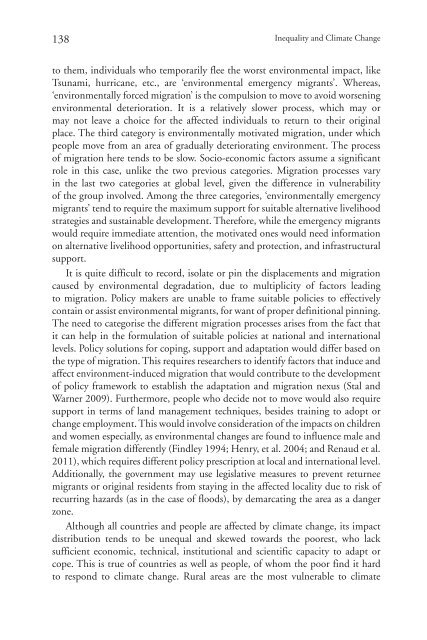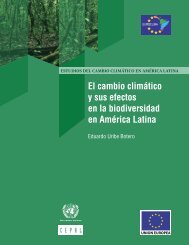Inequality and Climate Change Inégalité et changement climatique
Inequality
Inequality
You also want an ePaper? Increase the reach of your titles
YUMPU automatically turns print PDFs into web optimized ePapers that Google loves.
138<br />
<strong>Inequality</strong> <strong>and</strong> <strong>Climate</strong> <strong>Change</strong><br />
to them, individuals who temporarily flee the worst environmental impact, like<br />
Tsunami, hurricane, <strong>et</strong>c., are ‘environmental emergency migrants’. Whereas,<br />
‘environmentally forced migration’ is the compulsion to move to avoid worsening<br />
environmental d<strong>et</strong>erioration. It is a relatively slower process, which may or<br />
may not leave a choice for the affected individuals to r<strong>et</strong>urn to their original<br />
place. The third category is environmentally motivated migration, under which<br />
people move from an area of gradually d<strong>et</strong>eriorating environment. The process<br />
of migration here tends to be slow. Socio-economic factors assume a significant<br />
role in this case, unlike the two previous categories. Migration processes vary<br />
in the last two categories at global level, given the difference in vulnerability<br />
of the group involved. Among the three categories, ‘environmentally emergency<br />
migrants’ tend to require the maximum support for suitable alternative livelihood<br />
strategies <strong>and</strong> sustainable development. Therefore, while the emergency migrants<br />
would require immediate attention, the motivated ones would need information<br />
on alternative livelihood opportunities, saf<strong>et</strong>y <strong>and</strong> protection, <strong>and</strong> infrastructural<br />
support.<br />
It is quite difficult to record, isolate or pin the displacements <strong>and</strong> migration<br />
caused by environmental degradation, due to multiplicity of factors leading<br />
to migration. Policy makers are unable to frame suitable policies to effectively<br />
contain or assist environmental migrants, for want of proper definitional pinning.<br />
The need to categorise the different migration processes arises from the fact that<br />
it can help in the formulation of suitable policies at national <strong>and</strong> international<br />
levels. Policy solutions for coping, support <strong>and</strong> adaptation would differ based on<br />
the type of migration. This requires researchers to identify factors that induce <strong>and</strong><br />
affect environment-induced migration that would contribute to the development<br />
of policy framework to establish the adaptation <strong>and</strong> migration nexus (Stal <strong>and</strong><br />
Warner 2009). Furthermore, people who decide not to move would also require<br />
support in terms of l<strong>and</strong> management techniques, besides training to adopt or<br />
change employment. This would involve consideration of the impacts on children<br />
<strong>and</strong> women especially, as environmental changes are found to influence male <strong>and</strong><br />
female migration differently (Findley 1994; Henry, <strong>et</strong> al. 2004; <strong>and</strong> Renaud <strong>et</strong> al.<br />
2011), which requires different policy prescription at local <strong>and</strong> international level.<br />
Additionally, the government may use legislative measures to prevent r<strong>et</strong>urnee<br />
migrants or original residents from staying in the affected locality due to risk of<br />
recurring hazards (as in the case of floods), by demarcating the area as a danger<br />
zone.<br />
Although all countries <strong>and</strong> people are affected by climate change, its impact<br />
distribution tends to be unequal <strong>and</strong> skewed towards the poorest, who lack<br />
sufficient economic, technical, institutional <strong>and</strong> scientific capacity to adapt or<br />
cope. This is true of countries as well as people, of whom the poor find it hard<br />
to respond to climate change. Rural areas are the most vulnerable to climate





